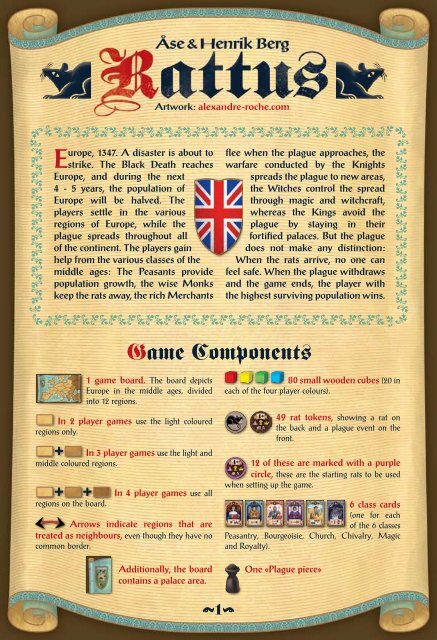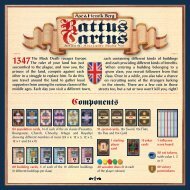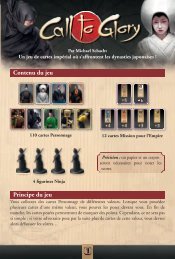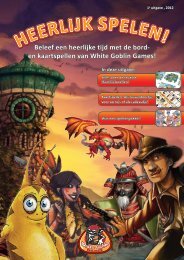Create successful ePaper yourself
Turn your PDF publications into a flip-book with our unique Google optimized e-Paper software.
1The game board islaid out on the table. Thesix class cards are laid outbeside it.Preparations2Each player chooses a colour andreceives all the wood<strong>en</strong> cubes of this colour.3The twelve starting rat tok<strong>en</strong>s (the ones marked withpurple circles) are mixed (face down), and one rat tok<strong>en</strong>is placed in each region of the board (still face down).In a 2/3-player game, only 8/10 regions are used, thus only8/10 starting rats are placed on the board. 4 The regular rat tok<strong>en</strong>sare mixed (face down)and kept as a supplybeside the board.With less than 4 players,some randomly drawnrat tok<strong>en</strong>s (not the startingrats) are removed (unse<strong>en</strong>)from the game:With 2 players, remove 12rat tok<strong>en</strong>s. With 3 players,remove 6 rat tok<strong>en</strong>s.The remaining starting rattok<strong>en</strong>s are mixed togetherwith the regular rats5The Plague Piece isplaced in a randomlychos<strong>en</strong> region.7Thereafter, the starting player makesthe first turn, and the other players followclockwise around the table.6The youngest player starts the game. Starting with him andgoing clockwise around the table, each player placestwo of his cubes in any region on the board. Thereafter,starting with the last player and going anti-clockwise around the table,each player places two more of his cubes in any region on the board.2 3
The yellow player curr<strong>en</strong>tly has the card «Knight (Chivalry)», the gre<strong>en</strong> player has the cards «Peasant (Peasantry)»and «Merchant (Bourgeoisie)», and the blue player has the «Monk (Church)», «Witch (Magic)» and «King (Royalty)».It’s the red player’s turn, andhe is about to <strong>en</strong>ter phase 3(«Move the Plague Piece»).He decides to move the plaguepiece into Gallia. Gallia curr<strong>en</strong>tlycontains three rat tok<strong>en</strong>s, two gre<strong>en</strong>cubes and one yellow cube.First, the plague spreads.Since Gallia contains three rattok<strong>en</strong>s, two new rat tok<strong>en</strong>s haveto be placed in one or two of th<strong>en</strong>eigbouring regions of Gallia. Thered player choosed to place themboth in Hispania.Thereafter, the plague ravages Gallia. One by one, the three rat tok<strong>en</strong>s are revealed:The first revealed tok<strong>en</strong> shows the limit value 1. Gallia contains three cubes, therefore the plaguewill have an outbreak. The rat tok<strong>en</strong> shows one Bourgeoisie symbol and one Church symbol. Sincethe gre<strong>en</strong> player curr<strong>en</strong>tly has the Merchant (Bourgeoisie) card, he has to remove one of his cubesand return it to his supply. The blue player has the Monk (Church) card, but since he does not haveany cubes in Gallia, he obviously does not have to remove any.Since Gallia still contains more cubes, the next rat tok<strong>en</strong> is revealed. It has the limit value 3.However, curr<strong>en</strong>tly Gallia only contains two cubes (since one of the gre<strong>en</strong> ones was just removed),therefore this rat tok<strong>en</strong> has no effect.Finally the last rat tok<strong>en</strong> is revealed. It turns out to have a limit value of 2, therefore the plague onceagain has an outbreak. The symbols giv<strong>en</strong> on this rat tok<strong>en</strong> are M («Majority»), Bourgeoisie andChurch. The gre<strong>en</strong> and yellow player are curr<strong>en</strong>tly tied for the Majority, therefore they both haveto remove one cube each.Consequ<strong>en</strong>tly, Gallia is nowcompletely devastated. Accordingto this last rat tok<strong>en</strong>, theplayer holding the Bourgeoisie card(gre<strong>en</strong>) and the player holding theChurch card (blue) should removeone cube each from the region,however, neither of them have anycubes in Gallia to remove.The red player’s turn now<strong>en</strong>ds, with the followingsituation:ExampleKing (Royalty)A player holding this card may,at any time during his turn, moveone of his cubes on the board to thepalace area. This cube must be tak<strong>en</strong>from a region containing no rats.Cubes in the palace area are safe forthe rest of the game, and count asregular cubes wh<strong>en</strong> counting scoreat the <strong>en</strong>d of the game.Knight (Chivalry)A player holding this card maymove the plague piece up to two stepsin phase C, before the effects of theplague are evaluated. Additionally,the player may, before the rattok<strong>en</strong>s are revealed, decide to let theplague piece count as two neutralpopulation cubes in the affected region for the purposeof evaluating the population limits on the rat tok<strong>en</strong>s.Example: If the plague piece is in Italia, the playermay for example move it to Scandia, if he holds theKnight card. If the player chooses to let the plague piececount as two extra cubes, and Scandia contains twowood<strong>en</strong> cubes, the plague will have an outbreak ev<strong>en</strong>if a rat with a limit value of 3 or 4 is revealed.The Class CardsNote: Only the player whose turn it is may use the special abilities of his class card(s). He may usethe abilities of each card only once each turn , and only before phase C is played (exception: Knight).Merchant (Bourgeoisie)A player holding this card may, atany time on his turn, move up to 3cubes of his own colour from oneregion to one of its neighbouringregions.Monk (Church)A player holding this card may,at any time on his turn, move anyone rat tok<strong>en</strong> from any region to aneighbouring region. This movem<strong>en</strong>tmay be performed either before orafter adding new cubes in phase B.Example: A region contains 3 rat tok<strong>en</strong>s. The playeron turn may add 3 cubes into this region. If he holdsthe Monk card, he may thereafter move one of the ratsinto a neighbouring region.Please note that no region is ever allowed to containmore than 3 rat tok<strong>en</strong>s. Therefore a player holdingthe Monk may not move a rat into a region alreadycontaining 3 rats.Peasant (Peasantry)A player holding this card may addone cube more than usual wh<strong>en</strong> headds cubes to a region in phase B(«Place new cubes on the board»).For example, he may add 4 cubes toa region containing 3 rat tok<strong>en</strong>s, or 1cube to a region without rat tok<strong>en</strong>s.Witch (Magic)A player holding this card may, atany time on his turn, look at any onerat tok<strong>en</strong> on the board. Thereafter,he may look at any other rat tok<strong>en</strong>on the board, either in the same or ina differ<strong>en</strong>t region. Finally, he may, ifhe wishes, swap the two selected rattok<strong>en</strong>s (this obviously only makes s<strong>en</strong>se if he looked atrat tok<strong>en</strong>s in two differ<strong>en</strong>t regions).6 7
Game EndThe game <strong>en</strong>ds after the turn during which either• the supply of rat tokes is depleted, or• a player manages to have all his cubes on the board at the <strong>en</strong>d of his turn (this is rare).• Thereafter a final round follows, in which all players, except the player having the last regularturn, may use the abilities of their class cards one last time.• This final round is played anticlockwise, beginning with the player sitting right of the player whohad the last regular turn.• In this final round the players are only allowedto use the abilities of the cards they curr<strong>en</strong>tly hold.• They are neither allowed to take any newcards, add cubes (exception: Peasant) nor movethe plague piece (exception: Knight). The cardshave their usual abilities, with the exceptionsgiv<strong>en</strong> in the frame on the right.Peasant: A player holding this card may adda cube of his own colour in any one region.Knight: A player holding this card maymove the plague piece up to two steps. Wh<strong>en</strong>the game <strong>en</strong>ds, the plague piece counts asusual as two neutral population cubes in theaffected region.• Finally, the plague ravages all the 12 regions, that is, one at a time all the rat tok<strong>en</strong>s arerevealed and evaluated.After this, the player with the most cubes still in play on the board (including any cubes in thepalace area) wins. In the case of a tie betwe<strong>en</strong> two or more players, the game is won by the player(among the tied players) that would have had the next turn if the game had not <strong>en</strong>ded.Artwork: alexandre-roche.comEnglish translation: Åse & H<strong>en</strong>rik BergProject manager: Jonny de Vrieswww.whitegoblingames.nl© 2010 <strong>White</strong> <strong>Goblin</strong> <strong>Games</strong>8







